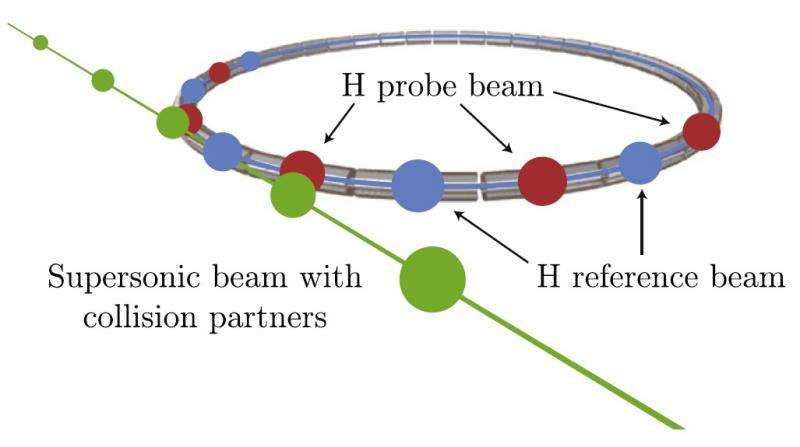June 3, 2015 feature
Proposed synchrotron could store supersonic beams of hydrogen atoms

(Phys.org)—With a circumference of 27 km (17 miles), the Large Hadron Collider (LHC) holds the claim of being the largest particle accelerator in the world, but it is far from being the only device of its kind. Currently there are about 30,000 particle accelerators in operation around the world, many of them used in medicine and industrial applications, and some of them small enough to fit on a tabletop.
In a paper published in the New Journal of Physics, physicists from VU University Amsterdam and the University of Oxford have presented a design for a new one-meter-diameter magnetic synchrotron—a circular particle accelerator like the LHC—that could be used to study collisions between neutral hydrogen atoms and other atoms and molecules.
The compact synchrotron could store beams of hydrogen atoms moving at a supersonic velocity of 600 meters per second (2100 km/hr, 1300 mph)—approximately twice the speed of sound. Supersonic beams of different neutral atoms and molecules would be injected into the ring from a supersonic beam source, enabling scientists to study their collisions inside the synchrotron.
The goal of many particle accelerators, such as the LHC, is to collide particles at very high energies, but there is very little experimental data on low-energy collisions. The proposed synchrotron aims to fill this niche. Even though the atoms and molecules inside the proposed device move at very high speeds, they all move in the same direction so that there is a small relative velocity between them when they collide. The resulting collisions would have energies below 100 K (8.6 meV); this is about 15 orders of magnitude lower than the LHC's recent record of 13 TeV, the highest energy ever for any particle accelerator.
"Until now, very little experimental data has been available for collisions below 100 K," coauthor Dr. Hendrick Bethlem at VU University Amsterdam told Phys.org. "A magnetic synchrotron provides a very general and very sensitive way to study collisions between hydrogen atoms with virtually any other atom or molecule at very low energy."

The scientists also estimate that the proposed synchrotron would have a sensitivity to collisions that is 100 to 1000 times higher than other devices that merge two beams, due to the fact that it could store the hydrogen beam for a long time, providing more time for accurate detection.
The device's features stem from its design, which uses magnetic rather than electric fields to store the atoms. The synchrotron consists of 40 hybrid hexapole lenses (magnets with six poles) arranged in a circle. The hybrid lenses combine permanent magnets with electromagnets. Since the hydrogen atoms being stored in the synchrotron are neutral, the magnetic fields act on the magnetic moments of the atoms rather than on their charge. The permanent magnets provide strong magnetic fields to confine the atoms to their circular orbit inside the ring, while the electromagnets keep the atoms in tight bunches as they travel around the ring by accelerating or decelerating the atoms as necessary.
"We have in our lab a similar device that uses electric fields to store neutral polar molecules," Bethlem said. "We are currently using that to study collisions between ammonia and hydrogen molecules. In this electric synchrotron, we are limited by the fact that the ammonia molecules have a maximum speed of 150 m/s, which means that if we want to study collisions at very low energy, we would need the collision partner also to be very slow. The advantage of the magnetic synchrotron is that we can store hydrogen atoms at a relatively high speed (600 m/s). It is straightforward to make intense beams at this speed, so we can collide hydrogen with about any atom or molecule at low energy."
The low-energy collisions that could be studied in the proposed device could be particularly useful for improving astrophysical models. Experiments in this area could involve not only hydrogen, but also helium, carbon monoxide, ammonia, and other gases present in the farthest reaches of the universe.
"The synchrotron will be used to record the collision cross section of hydrogen with atoms and molecules that are present in interstellar clouds at the relevant temperatures," Bethlem said. "This will allow us to model the chemistry in these clouds at much higher accuracy."
The next step for the researchers will be building the synchrotron. Because so little is known about low-energy collisions, the researchers hope that the new synchrotron will lead to many new discoveries, and are expecting the unexpected.
"What I personally find very interesting is the fact that, at low energies, you will see all sorts of resonances (that is, the outcome of the collision becomes very sensitive to the exact collision energy); basically because the atoms and molecules behave like waves rather than as bullets as they do at high energies," Bethlem said. "Certain resonances occur when all kinetic energy of the colliding particles is converted into internal energy and the atoms stick together after the collision. This is the exact analog of creating a new particle (such as the Higgs boson) in the LHC."
More information: Aernout P P van der Poel. "A compact design for a magnetic synchrotron to store beams of hydrogen atoms." New Journal of Physics. DOI: 10.1088/1367-2630/17/5/055012
Journal information: New Journal of Physics
© 2015 Phys.org




















